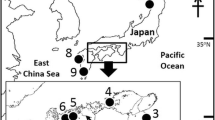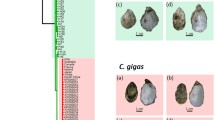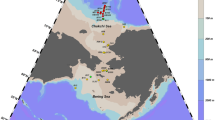Abstract
We used mitochondrial (mt) DNA barcoding to evaluate the species diversity of oysters sampled from the coast of Okinawa Island, Japan. Our analysis revealed the presence of a hitherto-unrecognized population of the Portuguese oyster Crassostrea angulata, a putative species closely related to the Pacific oyster C. gigas. Forty-eight Okinawan oyster specimens were collected and subjected to species diagnosis trials based on mtDNA barcodes. Of the 30 Crassostrea specimens, 17 were identified as C. angulata, seven as C. gigas and six as C. bilineata (syn. C. iredalei). The remaining 18 Saccostrea specimens formed several divergent clades in phylogenetic trees, although they could not be identified to species level because of the confounding taxonomy of the Saccostrea species complex. Our results stress the necessity for reviewing the species diversity of Okinawan oysters.






Similar content being viewed by others
References
Lam K, Morton B (2004) The oysters of Hong Kong (Bivalvia: Ostreidae and Gryphaeidae). Raff Bull Zool 52:11–28
Reece KS, Cordes JF, Stubbs JB, Hudson KL, Francis EA (2008) Molecular phylogenies help resolve taxonomic confusion with Asian Crassostrea oyster species. Mar Biol 153:709–721
Lam K, Morton B (2009) Oysters (Bivalvia: Ostreidae and Gryphaeidae) recorded from Malaysia and Singapore. Raff Bull Zool 57:481–494
Hong J-S, Sekino M, Sato S (2012) Molecular species diagnosis confirmed the occurrence of Kumamoto oyster Crassostrea sikamea in Korean waters. Fish Sci 78:259–267
WWF Japan (2009) Nansei Islands biological diversity evaluation report (in Japanese). World Wildlife Fund for Nature (Japan), Tokyo
Prefecture Okinawa (2005) Endangered Okinawan animals (Red Data Okinawa), 2nd edn (in Japanese). Okinawa Prefecture, Naha
Hebert PDN, Cywinska A, Ball SL, DeWaard JR (2003) Biological identifications through DNA barcodes. Proc R Soc Lond B Biol Sci 270:313–321
Hebert PDN, Stoeckle MY, Zemlak TS, Francis CM (2004) Identification of birds through DNA barcodes. PLoS Biol 2:e312
Lam K, Morton B (2006) Morphological and mitochondrial-DNA analysis of the Indo-West Pacific rock oysters (Ostreidae: Saccostrea species). J Molluscan Stud 72:235–245
Huber M (2010) Compendium of bivalves. ConchBooks, Hackenheim
Habe T (1977) Taxonomy of Japanese Mollusks: Bivalvia and Scaphopoda (in Japanese). Hokuryukan, Tokyo
Kubo H, Kurozumi T (1995) Marine and terrestrial mollusks in Okinawa (in Japanese). Okinawa Syuppan, Urazoe
Higo S, Callomon P, Goto Y (1999) Catalogue and bibliography of the marine shell-bearing Mollusca of Japan: Gastropoda, Bivalvia, Polyplacophora, Scaphopoda. Elle Scientific, Osaka
Nawa J (2009) Molluscan fauna of tidal flats in the Ryukyu Islands, Part 2: Okinawa, Miyako and Yaeyama Islands (in Japanese). Bull Nishinomiya Shell Mus 6, Nishinomiya Shell Museum, Nishinomiya, Hyogo
Boudry P, Heurtebise S, Collet B, Cornette F, Gérard A (1998) Differentiation between populations of the Portuguese oyster, Crassostrea angulata (Lamark) and the Pacific oyster, Crassostrea gigas (Thunberg), revealed by mtDNA RFLP analysis. J Exp Mar Biol Ecol 226:279–291
Folmer O, Black M, Hoeh W, Lutz R, Vrijenhoek R (1994) DNA primers for amplification of mitochondrial cytochrome c oxidase subunit I from diverse metazoan invertebrate. Mol Mar Biol Biotechnol 3:294–299
Sekino M, Sato S, Hong J-S, Li Q (2012) Contrasting pattern of mitochondrial population diversity between an estuarine bivalve, the Kumamoto oyster Crassostrea sikamea, and the closely related Pacific oyster C. gigas. Mar Biol. doi:10.1007/s00227-012-2037-z)
Banks MA, Hedgecock D, Waters C (1993) Discrimination between closely related Pacific oyster species (Crassostrea) via mitochondrial DNA sequences coding for large subunit rRNA. Mol Mar Biol Biotechnol 2:129–136
Tamura K, Peterson D, Peterson N, Stecher G, Nei M, Kumar S (2011) MEGA5: molecular evolutionary genetics analysis using maximum likelihood, evolutionary distance, and maximum parsimony methods. Mol Biol Evol 28:2731–2739
Thompson JD, Higgins DG, Gibson TJ (1994) CLUSTAL W: improving the sensitivity of progressive multiple sequence alignment through sequence weighting, position-specific gap penalties and weight matrix choice. Nucleic Acids Res 22:4673–4680
Nei M, Kumar S (2000) Molecular evolution and phylogenetics. Oxford University Press, New York
Saitou N, Nei M (1987) The neighbor-joining method: a new method for reconstructing phylogenetic trees. Mol Biol Evol 4:406–425
Kimura M (1980) A simple method for estimating evolutionary rate of base substitutions through comparative studies of nucleotide sequences. J Mol Evol 16:111–120
Klinbunga S, Khamnamtong N, Tassanakajon A, Puanglarp N, Jarayabhand P, Yoosukh W (2003) Molecular genetic identification tools for three commercially cultured oysters (Crassostrea belcheri, Crassostrea iredalei, and Saccostrea cucullata) in Thailand. Mar Biotechnol 5:27–36
Ó Foighil D, Gaffney PM, Wilbur AE, Hilbish TJ (1998) Mitochondrial cytochrome oxidase I gene sequences support an Asian origin for the Portuguese oyster Crassostrea angulata. Mar Biol 131:497–503
Wu X, Xu X, Yu Z, Wei Z, Xia J (2010) Comparison of seven Crassostrea mitogenomes and phylogenetic analysis. Mol Phyl Evol 57:448–454
Yu H, Li Q (2012) Complete mitochondrial DNA sequence of Crassostrea nippona: comparative and phylogenomic studies on seven commercial Crassostrea species. Mol Biol Rep 39:999–1009
Milbury CA, Gaffney PM (2005) Complete mitochondrial DNA sequence of the eastern oyster Crassostrea virginica. Mar Biotechnol 7:697–712
Librado P, Rozas J (2009) DnaSP v5: a software for comprehensive analysis of DNA polymorphism data. Bioinformatics 25:1451–1452
Nei M (1987) Molecular evolutionary genetics. Columbia University Press, New York
Bandelt HJ, Forster P, Röhl A (1999) Median-joining networks for inferring intraspecific phylogenies. Mol Biol Evol 16:37–48
Huvet A, Lapègue S, Magoulas A, Boudry P (2000) Mitochondrial and nuclear DNA phylogeography of Crassostrea angulata, the Portuguese oyster endangered in Europe. Conserv Genet 1:251–262
Huvet A, Fabioux C, McCombie H, Lapègue S, Boudry P (2004) Natural hybridization between genetically differentiated populations of Crassostrea gigas and C. angulata highlighted by sequence variation in flanking regions of a microsatellite locus. Mar Ecol Prog Ser 272:141–152
Lapègue S, Batista FM, Heurtebise S, Yu Z, Boudry P (2004) Evidence for the presence of the Portuguese oyster, Crassostrea angulata, in northern China. J Shellfish Res 23:759–763
Xia J, Yu Z, Kong X (2009) Identification of seven Crassostrea oysters from the South China Sea using PCR-RFLP analysis. J Molluscan Stud 75:139–146
Wang H, Qian L, Liu X, Zhang G, Guo X (2010) Classification of a common cupped oyster from southern China. J Shellfish Res 29:857–866
Barkley RA (1970) The Kuroshio current. Sci J 6:54–60
Emery KO, Niino H, Sullivan B (1971) Post-Pleistocene levels of East China Sea. In: Trekian KK (ed) Late Cenozoic glacial ages. Yale University Press, New Heaven, pp 381–390
Wang J, Wang P (1980) Relationship between sea-level changes and climatic fluctuations in East China Sea since Late Pleistocene (in Chinese). Acta Geogr Sinica 35:299–312
Xiao S, Li A, Jiang F, Li T, Wan S, Huang P (2004) The history of the Yangtze River entering sea since the last glacial maxima: a review and look forward. J Coast Res 20:599–604
Sakamaki S (1964) Ryukyu and Southeast Asia. J Asian Stud 23:383–389
Carlton JT (1985) Transoceanic and interoceanic dispersal of coastal marine organisms: the biology of ballast water. Oceanogr Mar Biol Annu Rev 23:313–371
Carlton JT (1989) Man’s role in changing the face of the ocean: biological invasions and implications for conservation of near-shore environments. Conserv Biol 3:265–273
Carlton JT, Hodder J (1995) Biogeography and dispersal of coastal marine organisms: experimental studies on a replica of a 16th-century sailing vessels. Mar Biol 121:721–730
Avise JC (2000) Phylogeography: the history and formation of species. Harvard University Press, Cambridge
Inaba A, Torigoe K (2004) Oysters in the world, part 2: systematic description of the recent oysters (in Japanese). Bull Nishinomiya Shell Mus 3, Nishinomiya Shell Museum, Nishinomiya, Hyogo
Polzin T, Daneschmand SV (2003) On Steiner trees and minimum spanning trees in hypergraphs. Oper Res Lett 31:12–20
Boudry P, Heurtebise S, Lapègue S (2003) Mitochondrial and nuclear DNA sequence variation of presumed Crassostrea gigas and Crassostrea angulata specimens: a new oyster species in Hong Kong? Aquaculture 228:15–25
Liu J, Li Q, Kong L, Yu H, Zheng X (2011) Identifying the true oysters (Bivalvia: Ostreidae) with mitochondrial phylogeny and distance-based DNA barcoding. Mol Ecol Resour 11:820–830
Ren J, Liu X, Zhang G, Liu B, Guo X (2009) Tandem duplication-random loss is not a real feature of oyster mitochondrial genomes. BMC Genomics 10:84
Yu H, Li Q (2011) Mutation and selection on the wobble nucleotide in tRNA anticodons in marine bivalve mitochondrial genomes. PLoS ONE 6:e16147
Lam K, Morton B (2003) Mitochondrial DNA and morphological identification of a new species of Crassostrea (Bivalvia, Ostreidae) cultured for centuries in the Pearl River Delta, Hong Kong, China. Aquaculture 228:1–13
Lazoski C, Gusmão J, Boudry P, Solé-Cava AM (2011) Phylogeny and phylogeography of Atlantic oyster species: evolutionary history, limited genetic connectivity and isolation by distance. Mar Ecol Prog Ser 426:197–212
Polson MP, Hewson WE, Eernisse DJ, Baker PK, Zacherl DC (2009) You say conchaphila, I say lurida: molecular evidence for restricting the Olympia oyster (Ostrea lurida Carpenter 1864) to temperate western North America. J Shellfish Res 28:11–21
Acknowledgments
We acknowledge the generosity of Dr. Tomoyuki Nakano, Field Science Education and Research Center of Kyoto University, who kindly provided us some of the articles cited in our study. We thank two anonymous reviewers and the handling editor for their comments on the manuscript. Financial support for this study was provided in part by a grant-in-aid (to HY) from Japan Society for the Promotion of Science (KAKENHI No. 23401005).
Author information
Authors and Affiliations
Corresponding author
Electronic supplementary material
Below is the link to the electronic supplementary material.
Rights and permissions
About this article
Cite this article
Sekino, M., Yamashita, H. Mitochondrial DNA barcoding for Okinawan oysters: a cryptic population of the Portuguese oyster Crassostrea angulata in Japanese waters. Fish Sci 79, 61–76 (2013). https://doi.org/10.1007/s12562-012-0577-2
Received:
Accepted:
Published:
Issue Date:
DOI: https://doi.org/10.1007/s12562-012-0577-2




